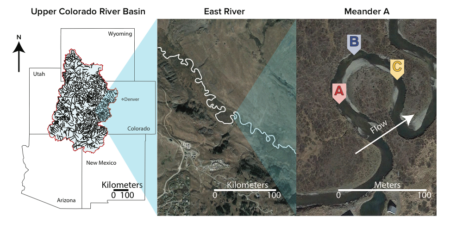
Location study site within the East River near Crested Butte, CO, part of the Upper Colorado River Basin.
Within the East River, near Crested Butte, CO, shifts in microbial composition and activity were observed in both stream water and the streambed associated with water mixing patterns, highlighting the tight linkage between microbial community assembly and function, and seasonal changes in hydrology. Specifically, rates of aerobic respiration increased during spring snowmelt, linked to the influx of abundant dissolved organic carbon. Moreover, strong river water downwelling into the riverbed had the additional effect of homogenizing the microbial community composition across depth profiles through the bed.
This work revealed multiple close linkages and feedbacks between physical, chemical, and microbiological processes in headwater streambed ecosystems, and highlights the need for increased characterization of upland biogeochemical cycles under future climate change scenarios.
Summary
Seasonal changes in river discharge in upland watersheds affect patterns of surface and groundwater mixing in the hyporheic zone (the region in the riverbed where these two water sources interact) that impacts how carbon compounds and dissolved metals are processed and exported from such catchments. This study focused on seasonal patterns of hyporheic mixing in the East River, CO, where seasonal snowmelt drives large fluctuations in the annual hydrograph. Using in situ depth-resolved temperature loggers and discrete sampling of pore fluids and riverbed sediments, we demonstrated that snowmelt-derived runoff drives increased downwelling of river water into the riverbed. Conversely, the riverbed experienced a greater influence from upwelling groundwater under low- and base-flow conditions. The movement of dissolved solutes was strongly correlated with seasonal changes in flow. Under high river discharge, increased dissolved oxygen concentrations in riverbed pore fluids stimulated aerobic heterotrophic metabolism, while conversely, this activity was depressed under baseflow conditions. Linked to changes in microbiome function, we demonstrated that this dynamic hydrology also influenced microbial community assembly; strong downwelling river water conditions had the effect of homogenizing microbial community composition across depth profiles through the riverbed.
Citation
C. M. Saup, S. R. Bryant, A. R. Nelson, K. D. Harris, A. H. Sawyer, J. N. Christensen, M. M. Tfaily, K. H. Williams, and M. J. Wilkins. (2019). “Hyporheic zone microbiome assembly is linked to dynamic water mixing patterns in snowmelt‐dominated headwater catchments.” Journal of Geophysical Research: Biogeosciences, 124, DOI: 10.1029/2019JG005189
